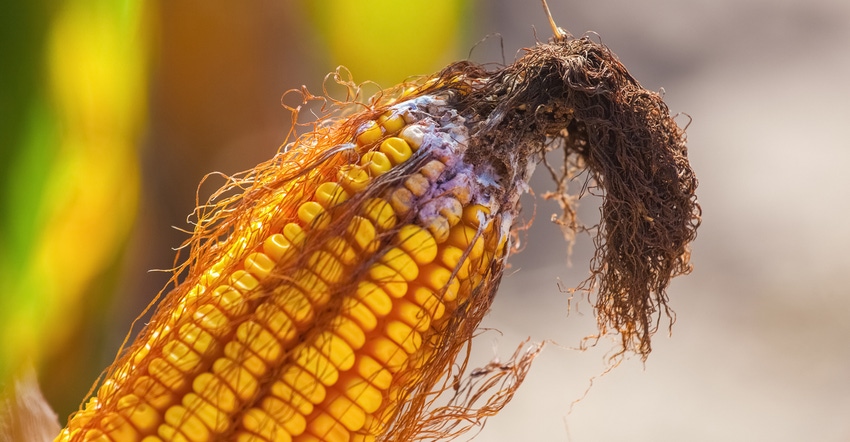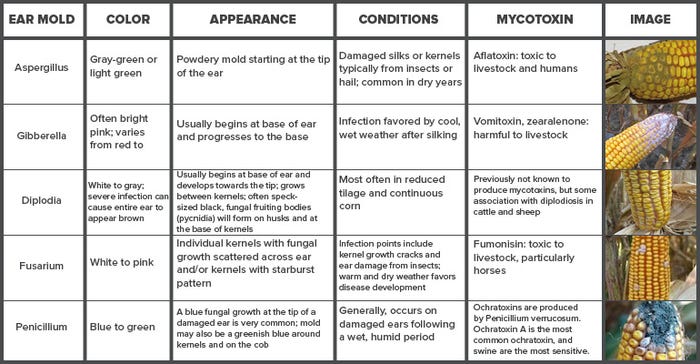October 1, 2018

Sponsored Content
Here’s a number: This year has been the fourth hottest year ever on record.1 Paired with precipitation, high heat and humidity can loosen husks on corn ears and bring the potential of ear rot, ear mold or kernel mold on corn. Most critically, these crop issues bring the risk of a fungus called mycotoxin, a toxic substance that can harm livestock.
Here’s another number: 36 percent of corn grown in America goes to livestock.2 What would it mean if 36 percent of your yields were carrying a toxic substance? The goal is to not have to find out. Let’s get there by learning how to spot it, how to manage it and how to prevent it. Let’s keep ear mold off our bottom line.
Know What You’re Up Against.
An important distinction is that there are several types of ear mold, and not all carry the mycotoxin substance. These different types are caused by different conditions, and will have a different appearance, like the color or the location of the mold. Below is a chart that will help you identify the various types of ear mold—and which ones often carry the worrisome mycotoxin.

Control It If You Got It.
All is not lost if you’re spotting plenty of ear mold on your corn. First, be sure to identify it with the above chart to get an idea of what the causes and risks are. If the ear mold might contain mycotoxins, it’s best to send it in to be tested to determine if it does carry mycotoxins that could harm livestock. Beyond that, managing mycotoxins comes down to harvesting, drying and storing. If your fields appear to have a low amount of corn with ear mold, harvest that grain and run it through the dryer to prevent mold from getting worse or causing storage issues. Finally, you’ll want to consider the prevention methods below.
Stop It Before It Starts.
The best way to control ear mold is to prevent it altogether. Certain hybrids with a closed, tight husk will reduce risk of ear mold—but keep in mind the tight husk will not dry down as quickly in the fall. Keeping insect pressures low will help prevent kernel feeding, particularly from troublesome Japanese beetles that damage crops and attract other feeders.
If you already have ear mold, you may want to consider switching off of corn for a year, allowing residue to break down in the soil and eliminate the mold-causing pathogen. If this is not an option, the best method of prevention is to bury the residue as much as possible.
Reduce Your Risks.
It’s not the most appealing business strategy, but by following the above steps, your farm and its yields are better protected from being infected. Keep an eye on your fields, know what you’re up against and act fast once you do. Above all, be mindful next year if it’s a challenge this year. With mother nature’s threats often out of our hands, you have to do what you can to keep ear mold off of your crops—and as far away as possible from your bottom line.
Click here to learn more from our LG agronomy team.
References:
2018 Is on Pace To Be the 4th-hottest Year on Record
Eric Levenson-Brandon Miller - https://www.cnn.com/2018/07/28/us/2018-global-heat-record-4th-wxc/index.htmlIt's Time To Rethink America's Corn System
Jonathan Foley - https://www.scientificamerican.com/article/time-to-rethink-corn/
Penicillium and Fusarium photos courtesy of University of Nebraska.
Gibbereall and Diplodia photos courtesy of J. Grogan, AgReliant Genetics.
Aspergillus photo courtesy of Purdue University.
About the Author(s)
You May Also Like




